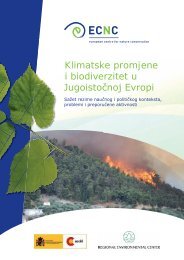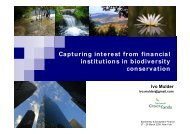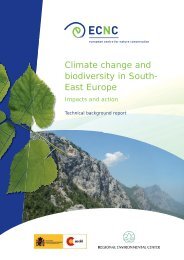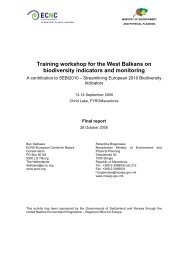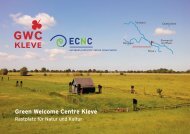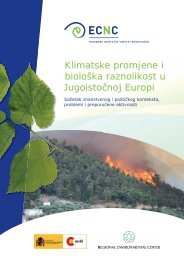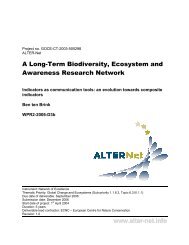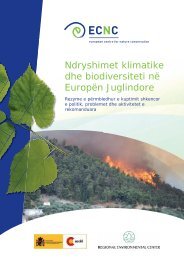semi-natural habitats. One respondent commented that, “agri-environmental schemes are very goodinstruments for implementing ecological networks, in effect it is a type of voluntary network that exists already”.Integration of SectorsAs with interviewees in <strong>the</strong> o<strong>the</strong>r countries in this study, several respondents acknowledge that in <strong>the</strong> UK<strong>the</strong>re is a lack of integration of differing sectors in biodiversity policies. Respondents stated that generallydifferent sectors or professions stay within <strong>the</strong>ir own networks and this lack of integration of sectorshampers finding solutions in nature protection where integration of policies and <strong>the</strong>refore integration ofsectors is required, ”academics, policy-makers and practitioners live in different silos, even different sectorswithin <strong>the</strong> same silos, so <strong>the</strong>re are few who try to integrate and make links’’.However <strong>Ecological</strong> <strong>Network</strong>s was seen by one respondent as an opportunity to integrate sectors,“<strong>Ecological</strong> <strong>Network</strong>s, landscape thinking, is actually an integrating concept it can cut across <strong>the</strong>se silos[sectors] of nature conservation work”.Linkage to <strong>the</strong> planning system was highlighted as a signficant gap and regarded as a necessary requirementfor an effective national ecological network by numerous respondents. The Office of <strong>the</strong> DeputyPrime Minister (ODPM) is <strong>the</strong> Government Department responsible for planning policy. There have beenefforts by some respondents to involve this department, but without success. Again, as with o<strong>the</strong>r countriesin <strong>the</strong> report, <strong>the</strong> need for integration of government departments was also seen as important in <strong>the</strong>UK. There will be a future change in England with <strong>the</strong> government agency structure of English Nature,Countryside Agency and <strong>the</strong> Rural Development Service merging. This integration was considered by arespondent as an opportunity to integrate <strong>the</strong> different responsibilities for <strong>the</strong> landscape and <strong>the</strong>refore itwas seen as a favourable time for using <strong>the</strong> ecological network approach.Changes in <strong>the</strong> ‘traditional conservation approach’Several respondents highlighted <strong>the</strong> need for a change in <strong>the</strong> mindset of nature conservationists awayfrom <strong>the</strong> ‘traditional conservation approach’, as this is seen to create a barrier to <strong>the</strong> national ecologicalnetwork concept. Respondents spoke about <strong>the</strong> fact that <strong>the</strong> traditional approach of conserving specificprotected areas can now be considered detrimental to overall biodiversity conservation. This was spokenabout from a UK perspective, but actually considered to be a worldwide issue. Biodiversity could be describedas having become an exclusive sector and this was thought to have pushed biodiversity to <strong>the</strong> marginsand it is now thought that this is not a progressive way forward and biodiversity conservation mustbe seen as an integral part of sustainable development in order to ensure its’ protection. This new line ofthinking could be seen as a threat to some in <strong>the</strong> nature conservation sector, who have relied upon andused <strong>the</strong> traditional approaches. General thought included <strong>the</strong> need for a major change of thoughtamongst <strong>the</strong> nature conservation Sector. “We cannot afford to polarise land use, we want to see a generalreduction in <strong>the</strong> intensity of land use between protected areas”. With saying this, it was acknowledgedthat <strong>the</strong> UK, and <strong>the</strong> rest of Europe, would probably continue with <strong>the</strong> focus on designated sites, howeverit was still thought that taking on <strong>the</strong> new ways of thinking could target energy more effectively.<strong>Ecological</strong> networks provide <strong>the</strong> opportunity of taking forward this new concept of <strong>the</strong> wider protection ofnature as opposed to concentrating on protected areas, as one respondent stated: “It is difficult to makepeople aware of that, nature conservationists, about <strong>the</strong> wider protection of nature not just concentratingon protection only.”Involvement of StakeholdersSome of <strong>the</strong> large landowners in <strong>the</strong> UK, such as <strong>the</strong> National Trust, Water Companies and <strong>the</strong> Ministry ofDefence, are perceived as having made progress in nature conservation and being receptive to <strong>the</strong> conceptof a national ecological network. The Highways Agency (England) is also active in this area. Howeverrespondents still felt that major landowners and government agencies needed to be more aware and involvedin <strong>the</strong> concept of ecological networks. It was thought that <strong>the</strong>re needs to be greater legitimacy givento ecological networks, particularly by <strong>the</strong> government agencies, in order for it to gain fur<strong>the</strong>r momentum.39
There is evidence of an active dialogue between such government departments, government agencies, <strong>the</strong>landowners and NGOs. Several respondents acknowledged <strong>the</strong> fact that generally <strong>the</strong>re is good communicationbetween <strong>the</strong> majority of stakeholders, but that <strong>the</strong>y could work more effectively toge<strong>the</strong>r than <strong>the</strong>y donow. There was optimism that if all of <strong>the</strong> relevant stakeholders “came to <strong>the</strong> table’’, including <strong>the</strong>Government, <strong>the</strong>n a solution or a way forward for implementation of <strong>Ecological</strong> <strong>Network</strong>s would be foundand that a strength in UK policy was <strong>the</strong> ability to create effective partnerships, particularly at <strong>the</strong> local level.Whilst on one level <strong>the</strong>re is considered to be a lack of integration of sectors and a lack of integration ofgovernment departments, it is acknowledged by respondents that <strong>the</strong>re are partnerships and links betweenorganisations, particularly where day-to-day work of one organisation is directly affected by <strong>the</strong>o<strong>the</strong>r. Communication is lacking where <strong>the</strong>re is less direct contact between organisations. BiodiversityAction Plans and Local BAPS have provided <strong>the</strong> opportunity for improvements in communication in naturepolicy, between organisations particularly at <strong>the</strong> ground level. One respondent supported current communicationlinks, “I think that in <strong>the</strong> UK <strong>the</strong> ecological network will emerge on <strong>the</strong> ground, we are good atcreating partnerships.”Government agencies have involved stakeholders in projects that have happened on a local scale including<strong>the</strong>ir national representatives such as <strong>the</strong> National Farmers’ Union (NFU), generally when appropriate.The NFU respondent thought that <strong>the</strong>re was an adequate dialogue between <strong>the</strong>m and <strong>the</strong> governmentagencies and that when it was necessary <strong>the</strong> agencies would come to <strong>the</strong>m. Relevant government agencies,with <strong>the</strong> responsibility for <strong>the</strong> environment, generally have good communication with those sectorssuch as conservation NGOs or farmers with whom <strong>the</strong>y need to get involved to carry out policy deliverables,that are on <strong>the</strong>ir priority list, on a practical day-to-day basis. This includes communication not only ona “same level” basis but also communication on a less frequent basis, connecting to <strong>the</strong> higher level e.g.agency to agency communication on a frequent basis with formal, planned meetings involving agencygovernment departments.The Forestry Sector (including <strong>the</strong> Forestry Commission and NGOs such as <strong>the</strong> Woodland Trust) is seento have been active in <strong>the</strong> concept of ecological networks and have driven this concept forward throughvarious research papers and policy work. Whilst much work has been done on ecological networks, thissector highlights <strong>the</strong> fact that <strong>the</strong> Forestry Commission, as a government department, is not as integratedas it should be with <strong>the</strong> Department of Environment, Food and Rural Affairs (DEFRA), <strong>the</strong> governmentdepartment responsible for nature protection and environment. Therefore if government departments withsimilar responsibilities have barriers <strong>the</strong>n it was recognised that reaching departments that are not so obviouslyconnected e.g. Department of Transport or Health would be a much bigger challenge.Government agencies may involve stakeholders by promoting <strong>the</strong>ir work on ecological networks throughvarious types of instrumental communication such as brochures, leaflets, reports and also through exhibitions,telephone helplines and internet sites. All of <strong>the</strong> government agencies have formal stakeholderconsultation processes where stakeholders can provide feedback on intended plans or protected areas orproposed developments.Research Activities on <strong>Ecological</strong> <strong>Network</strong>sIt was considered that research projects that have been carried out on <strong>the</strong> implementation of ecologicalnetworks, for example, <strong>the</strong> LIFE-ECONET project in Cheshire, should be greater promoted and disseminated.It was thought that <strong>the</strong> results of projects such as <strong>the</strong>se, when valuable to policymaking, could beused and fur<strong>the</strong>r developed and that this was seen as an important next step.This LIFE–ECONET project was carried out in numerous countries, including Cheshire (England), andimplemented an ecological network concept at <strong>the</strong> local level, it is well recognised in <strong>the</strong> UK and was citedas an example by all respondents. However many respondents did not know how it would develop fur<strong>the</strong>r,or had not been advised as to any potential next steps, even those that may have had some type of involvementin <strong>the</strong> project. This perhaps underlines <strong>the</strong> importance of communicating research effectively inorder for it to be actively linked to policy development.40
- Page 1 and 2: european centre for nature conserva
- Page 3 and 4: Published by:This publication was m
- Page 5 and 6: Executive SummaryIn 2003, ECNC publ
- Page 7 and 8: ●●The study has highlighted the
- Page 9 and 10: NetherlandsEstoniaNorwayUnited King
- Page 11 and 12: PEEN - a Europe wide ecological net
- Page 13 and 14: Experiences at the EU level, regard
- Page 15 and 16: there may also be huge variations i
- Page 17 and 18: on the effectiveness of implementat
- Page 19 and 20: e the working group involving natio
- Page 21 and 22: Opportunities or challenges for eco
- Page 24 and 25: As mentioned above, there are a lot
- Page 26 and 27: It was felt by some respondents tha
- Page 28 and 29: gained by the work of the NGOs, sci
- Page 30 and 31: nature conservation societies (Prov
- Page 32 and 33: ● Local level support for interna
- Page 34 and 35: istics of the Norwegian landscape,
- Page 36 and 37: policymaking, involving stakeholder
- Page 38 and 39: Some respondents thought a map was
- Page 42 and 43: In Scotland, there is a lot of work
- Page 44 and 45: policymakers, researchers, scientis
- Page 46 and 47: Experience and expertise:Over the p
- Page 48 and 49: knowledge also exists regarding the
- Page 50 and 51: At an international level, this is
- Page 52 and 53: lack of integration of policies reg
- Page 54 and 55: ottom-up approach of PEEN requires
- Page 56 and 57: 5 ReferencesSandra Rientjes & Kater
- Page 58 and 59: Methodological Outline●●●●
- Page 60 and 61: CPA 1 A3Communicating PEENDESK STUD
- Page 62 and 63: IntroductionThe desk review of the
- Page 64 and 65: The following two tables, adapted f
- Page 66 and 67: Habitats DirectiveAssessment of the
- Page 68 and 69: Ramsar ConventionAssessment of the
- Page 70 and 71: Assessment ofCommunication,Educatio
- Page 72 and 73: and other European states, four rep
- Page 74 and 75: The Act on Sustainable Development
- Page 76 and 77: In Germany nature conservation by l
- Page 78 and 79: The management of protected areas f
- Page 80 and 81: The NvM and the NMP4 are devoted to
- Page 82 and 83: Assessment of policy and legislatio
- Page 84 and 85: A Species Action Plan (SAP) has bee
- Page 86 and 87: CPA 1 A3Communicating PEENExecutive
- Page 88 and 89: Practical experiences with developi



